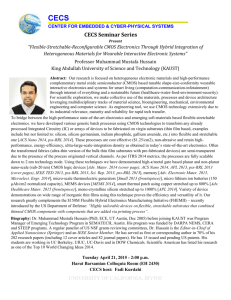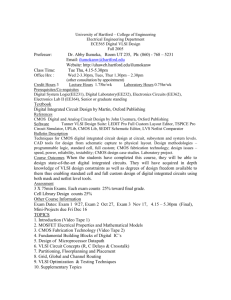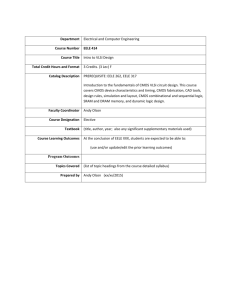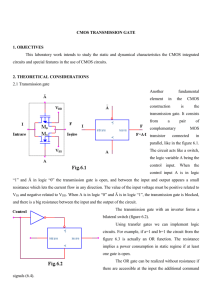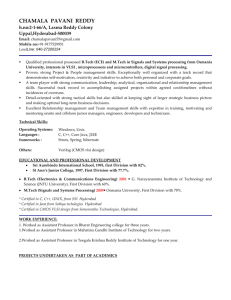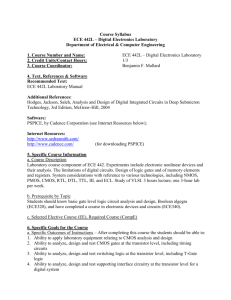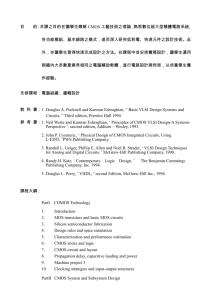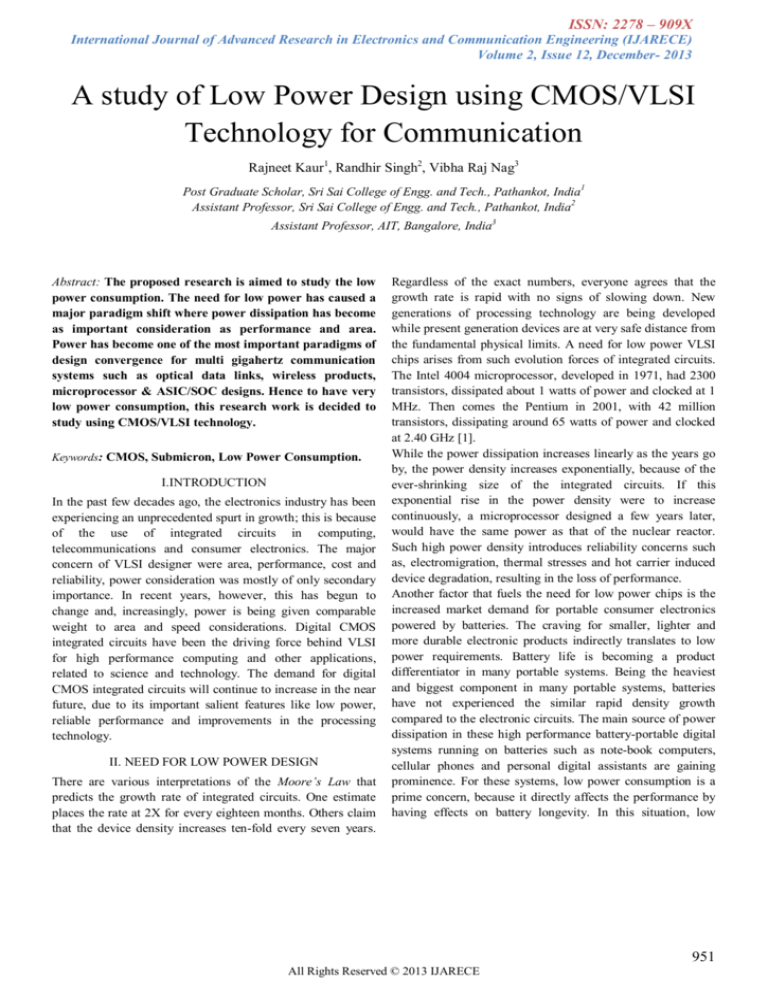
ISSN: 2278 – 909X
International Journal of Advanced Research in Electronics and Communication Engineering (IJARECE)
Volume 2, Issue 12, December- 2013
A study of Low Power Design using CMOS/VLSI
Technology for Communication
Rajneet Kaur1, Randhir Singh2, Vibha Raj Nag3
Post Graduate Scholar, Sri Sai College of Engg. and Tech., Pathankot, India1
Assistant Professor, Sri Sai College of Engg. and Tech., Pathankot, India2
Assistant Professor, AIT, Bangalore, India3
Abstract: The proposed research is aimed to study the low
power consumption. The need for low power has caused a
major paradigm shift where power dissipation has become
as important consideration as performance and area.
Power has become one of the most important paradigms of
design convergence for multi gigahertz communication
systems such as optical data links, wireless products,
microprocessor & ASIC/SOC designs. Hence to have very
low power consumption, this research work is decided to
study using CMOS/VLSI technology.
Keywords: CMOS, Submicron, Low Power Consumption.
I.INTRODUCTION
In the past few decades ago, the electronics industry has been
experiencing an unprecedented spurt in growth; this is because
of the use of integrated circuits in computing,
telecommunications and consumer electronics. The major
concern of VLSI designer were area, performance, cost and
reliability, power consideration was mostly of only secondary
importance. In recent years, however, this has begun to
change and, increasingly, power is being given comparable
weight to area and speed considerations. Digital CMOS
integrated circuits have been the driving force behind VLSI
for high performance computing and other applications,
related to science and technology. The demand for digital
CMOS integrated circuits will continue to increase in the near
future, due to its important salient features like low power,
reliable performance and improvements in the processing
technology.
II. NEED FOR LOW POWER DESIGN
There are various interpretations of the Moore’s Law that
predicts the growth rate of integrated circuits. One estimate
places the rate at 2X for every eighteen months. Others claim
that the device density increases ten-fold every seven years.
Regardless of the exact numbers, everyone agrees that the
growth rate is rapid with no signs of slowing down. New
generations of processing technology are being developed
while present generation devices are at very safe distance from
the fundamental physical limits. A need for low power VLSI
chips arises from such evolution forces of integrated circuits.
The Intel 4004 microprocessor, developed in 1971, had 2300
transistors, dissipated about 1 watts of power and clocked at 1
MHz. Then comes the Pentium in 2001, with 42 million
transistors, dissipating around 65 watts of power and clocked
at 2.40 GHz [1].
While the power dissipation increases linearly as the years go
by, the power density increases exponentially, because of the
ever-shrinking size of the integrated circuits. If this
exponential rise in the power density were to increase
continuously, a microprocessor designed a few years later,
would have the same power as that of the nuclear reactor.
Such high power density introduces reliability concerns such
as, electromigration, thermal stresses and hot carrier induced
device degradation, resulting in the loss of performance.
Another factor that fuels the need for low power chips is the
increased market demand for portable consumer electronics
powered by batteries. The craving for smaller, lighter and
more durable electronic products indirectly translates to low
power requirements. Battery life is becoming a product
differentiator in many portable systems. Being the heaviest
and biggest component in many portable systems, batteries
have not experienced the similar rapid density growth
compared to the electronic circuits. The main source of power
dissipation in these high performance battery-portable digital
systems running on batteries such as note-book computers,
cellular phones and personal digital assistants are gaining
prominence. For these systems, low power consumption is a
prime concern, because it directly affects the performance by
having effects on battery longevity. In this situation, low
951
All Rights Reserved © 2013 IJARECE
ISSN: 2278 – 909X
International Journal of Advanced Research in Electronics and Communication Engineering (IJARECE)
Volume 2, Issue 12, December- 2013
power VLSI design has assumed great importance as an active
and rapidly developing field.
Another major demand for low power chips and systems
comes from the environmental concerns. Modern offices are
now furnished with office automation equipments that
consume large amount of power. A study by American
Council for an Energy-Efficient Economy estimated that office
equipment account for 5% for the total US commercial energy
usage in 1997 and could rise to 10% by the year 2004 if no
actions are taken to prevent the trend [2].
III. RECENT TRENDS IN CMOS TECHNOLOGY
The evolution of important parameter such as integrated
circuit (IC) complexity, gate length, switching delay, supply
voltage with a prospective vision down to the 11 nm CMOS
technology.The naming of the technology nodes (130, 90, 65,
32, 22, 16, 11nm) comes from the International Roadmap for
semiconductors [ITRS2009]. The trends of CMOS technology
improvement continues to be driven by the need to
1.
2.
3.
4.
Integrate more functions within a given silicon area
Reduce Fabrication cost
Increase operating speed
Dissipate less power
Table 1 gives an overview of the key parameters for
technological nodes from 130nm, introduced in 2001, down to
11nm, which is supposed to be in production in the 2015-2018
timeframe [3] [4].
Table 1. Technological evolution and forecast upto 2015 [4]
breakdown voltages, low transconductance-to-current ratio,
and low substrate resistivity, as will be discussed successively.
a) Low Breakdown Voltages
The gate oxide breakdown occurs when the electric field in
the oxide exceeds a certain value (about 0.07 V/°A in silicon
dioxide). This process is destructive to the transistor because it
results in a permanent short circuit between the gate and the
channel. As the gate length in a CMOS technology shrinks, so
does the thickness of gate oxide to avoid short channel effects
[6]. Thus, the maximum allowable gate voltage for a submicron CMOS device is greatly limited. In addition to gate
oxide breakdown, the drain-substrate pn junction will conduct
a large current if the reverse bias applied to it exceeds a
certain value [6]. This breakdown is nondestructive, but limits
the maximum PA voltage swing at the drain of the device.
b) Low Transconductance-to-current Ratio
When the velocity saturates, the ratio of the transconductance
to the current for a short-channel MOS device is [7]
gm
1
1
I VGS Vt Vov
For a bipolar device, this ratio is 1=VT , where the thermal
voltage VT is 26 mV. In contrast, the overdrive Vov for MOS
transistors is typically chosen as several hundred mV. Thus,
the transconductance per given current is much lower for
MOS devices than for bipolar devices. To accommodate this
small transconductance, either the input signal amplitude or
the device size of the PA output stage has to be increased.
However, either approach will increase the loading for the
driving stage, thus resulting in higher power consumption of
the driver stage. Increasing the input signal amplitude can also
dramatically degrade the PA linearity because the third-order
nonlinearity of the device current is directly proportional to
the cube of the input voltage amplitude. Thus, higher
nonlinearity will be expected for MOS devices than for
bipolar devices.
c) Low Substrate Resistivity
IV. LIMITATIONS OF SUB-MICRON CMOS
TECHNOLOGY
In order to design a CMOS PA, one must first understand the
limitations of submicron CMOS technology with respect to
PA implementations. The major limitations are low
In an integrated implementation, a PA resides on the same
substrate as other circuit blocks, some of which may be very
sensitive. Since many CMOS processes use low resistivity
substrates, PA signals can be easily conducted across long
chip distance to corrupt adjacent circuit blocks. Thus,
substrate isolation is a crucial design issue for integrated PA
implementations. In addition, a low-resistivity substrate has a
detrimental effect on spiral inductors built above it [8]. This is
because the low resistivity allows for creation of eddy currents,
952
All Rights Reserved © 2013 IJARECE
ISSN: 2278 – 909X
International Journal of Advanced Research in Electronics and Communication Engineering (IJARECE)
Volume 2, Issue 12, December- 2013
which reduce the effective magnetic field, thus the quality
factor of the spiral inductor.
V.CONCLOSION
The basic theory of Low Power Design along with various
Limitation has been discussed This paper has illustrated the
significance of Low Power design in the communication and
the trends in CMOS Technology based on technology
information available from integrated manufacturers. This
article reviews various strategies for designing low power
circuit and system .The article concludes with the future
challenges that must be met to design low power, high
performance systems.
REFERENCES
[1] A. P. Chandrakasan, S. Sheng, and R. W. Brodersen, “Low
Power CMOS Digital Design,” IEEE Journal of Solidstate Circuits, Vol. 27, No. 04, pp. 473-484, April 1999.
[2] J. M. Rabaey, and M. Pedram, “Low Power Design
Methodologies,” Kluwer Academic Publishers, 2002.
[3] C X Chen et al, “ A cost effective 32mm High-K Metal
Gate CMOS Technology for Low Power Application with
Single-Metal/Gate-First Process”, Symposium on VLSI
Technology Digest of Technical Paper,2008,pp.88-89.
degree in Electronics and Communication Engineering from
College of Engineering and Management, Kapurthala
affiliated to Punjab Technical University, Jalandhar, India in
2011. Her research interests in CMOS and VLSI Technology.
Er. Randhir Singh (Assistant Professor
and Head) received his M. Tech. Degree in Electronics and
Communication Engineering from Beant College of
Engineering and Technology, Gurdaspur (Punjab) affiliated to
Punjab Technical University, Jalandhar (Punjab). He is
presently working as Assistant Professor (H.O.D),
Electronics and Communication Engineering Department,
Sri Sai College of Engineering and Technology, Pathankot
(Punjab) and pursuing in PhD. Electronics and
Communication from Punjab Technical University. His
research interests include Speech signal processing,
Digital signal Processing, Image processing, Analog and
Digital Communication, Electronics and control systems,
etc. and having more than 30 publications in
national/international conferences and journals and a lot of
experience in guiding M. Tech students.
[4] ITRS roadmap for Semiconductor may be downloaded
from http://www.itrs.net.
[5] Etienne Sicard and Syed Mahfuzul Aziz,”Introducing 32nm Technology in Microwind”, Microwind application
note,
[6] Y. Tsividis, Operation and Modeling of The MOS
Transistor. Boston, MA: McGraw- Hill, second ed., 1999.
[7] P. R. Gray, P. J. Hurst, S. H. Lewis, and R. G. Meyer,
Analysis and Design of Analog Integrated Circuits. New
York, NY: Wiley, 2001.
[8] R. S. Narayanaswami, RF CMOS Class C Power
Amplifiers for Wireless Communications. PhD thesis,
University of California, Berkeley, Fall 2001.
AUTHOR PROFILE
Ms. Vibha Raj Nag received her M. Tech
in Electronics and Communication from Beant College of
Engineering and Technology, Gurdaspur, affiliated to Punjab
Technical University Jalandhar. She completed her B.Tech in
Electronics and Communication in 2008 from C.T.I.E.M.T,
Jalandhar affiliated to Punjab Technical University Jalandhar.
She is currently working as Assistant Professor in the
Department of Electronics and Communication Engineering at
AIT, Bengaluru (Karnataka). She is Involved in teaching since
2008 and her major research interest includes Antenna
Designing, Wireless Communication and aspect of CMOS
VLSI design etc. and having more than 20 publications in
national/international conferences and journals and experience
in guiding M. Tech students.
Er. Rajneet Kaur is doing M. Tech in
Electronics and Communication from Sri Sai College of
Engineering and Technology, Badhani, affiliated to Punjab
Technical University Jalandhar. She completed her B.Tech
953
All Rights Reserved © 2013 IJARECE


